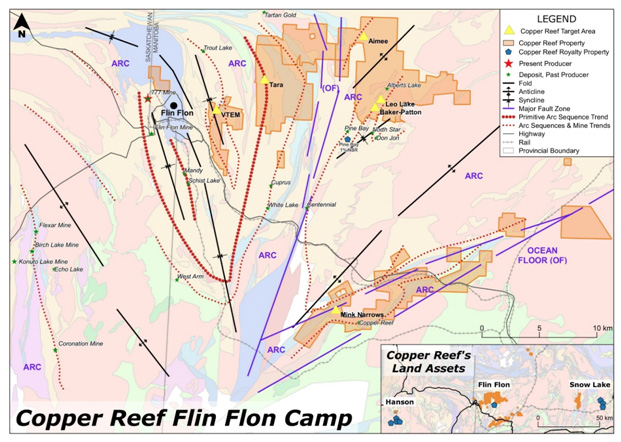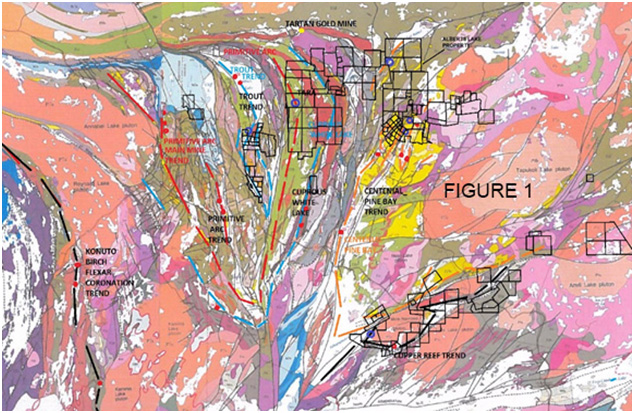News Releases
Copper Reef Reports High-Grade Infill Intercept at East Big Island
April 20, 2020
Copper Reef Mining Corporation (CSE: CZC) (the "Company") is pleased to provide the zinc-copper-silver results for East Big Island infill drillhole TZ-20-07 testing the Tara Massive Sulphide Zone. The drillhole is part of the 4,300 metre drill program that commenced on January 23, 2020. As previously reported by the Company (see press release dated April 6, 2020) and prior to receipt of zinc-copper-silver assays, gold assay results were received and reported as 5.45 g/t gold over 15.28 metres between 57.00 and 72.28 metres. The Company, having received the other assays, can now report that TZ-20-07 intercepted 15.28 metres core length of 21.1% zinc, 0.99% copper, 142.4 g/t silver and 5.45 g/t gold between 57.00 and 72.28 metres. A preliminary estimation of true width for this hole is believed to be between 50 to 55% of core length but requires further validation.
Table 1 provides a breakdown of assay intervals for TZ-20-07.
Table 1. Copper Reef Drillhole TZ-20-07 Assay Results
| Zone | From (m) | To (m) | Core Length* (m) | Zinc % | Copper % | Silver g/t | Gold g/t |
|---|---|---|---|---|---|---|---|
| Zinc Stringer Zone | 29.46 | 36.50 | 7.04 | 2.30 | 0.13 | 10.5 | 0.65 |
| Copper Stringer Zone | 40.60 | 47.19 | 6.59 | 0.77 | 1.07 | 32.3 | 0.80 |
| (includes) | 46.10 | 46.58 | 0.48 | 1.72 | 1.49 | 98.3 | 2.21 |
| Massive Sulphide Zone | 57.00 | 72.28 | 15.28 | 21.10 | 0.99 | 142.4 | 5.45 |
| (includes) | 60.90 | 61.50 | 0.60 | 37.88 | 0.45 | 127.5 | 24.14 |
| Massive Sulphides | 75.21 | 76.87 | 1.66 | 20.50 | 0.36 | 53.7 | 1.35 |
*True widths are believed to be between 50-55% of core length, but this estimation is preliminary and requires further validation.
Similar high-grade results were intercepted when the Massive Sulphide Zone was first drilled in 1987 to 1988 by Westfield Minerals Limited as provided in Table 2. The Zone is defined by twenty drill holes that returned zinc-copper-silver-gold assays over variable widths.
In this recent program, two drillholes were completed and designed to intercept the Tara massive sulphide horizon. Drillhole TZ-20-07 was successful in intercepting shallow massive sulphides within the known deposit, while the second drillhole (TZ-20-11) tested a geophysical target anticipated to be the down-dip extension of the Tara horizon. TZ-20-11 was found to be a barren sulphides (pyrrhotite) inter-pillow chert horizon in the hanging wall separate from the Tara deposit. This also occurs at the Main Mine which was operated by Hudbay Minerals Inc. Results from these programs and recent geophysical borehole surveys are being examined with structural, stratigraphic and alteration data, to continue with this evaluation.
Table 2. Westfield Minerals Tara Deposit Select High-Grade Intercepts from 1987 to 1988 Diamond Drill Program
| Drillhole # | From (m) | To (m) | Core Length (m) | Zinc % | Copper % | Silver g/t | Gold g/t |
|---|---|---|---|---|---|---|---|
| 87-3 | 22.0 | 34.4 | 12.4 | 22.40 | 0.58 | 93.58 | 5.83 |
| 87-11 | 24.9 | 32.3 | 7.4 | 20.31 | 1.19 | 110.03 | 7.20 |
| 87-12 | 41.9 | 49.7 | 7.8 | 23.76 | 1.30 | 102.50 | 5.14 |
| 88-15 | 46.7 | 49.1 | 2.4 | 30.60 | 0.88 | 93.24 | 5.48 |
Data Source: “The Big Island Lake Project, Westfield Minerals Limited - Goldbrae Developments Ltd., Flin Flon Manitoba, Exploration Report, dated May 1987 - May 1988, August 31, 1988. Westfield Minerals drill data has not been validated by Copper Reef.
Conversion used: 1 troy oz/short ton = 34.28 gram/metric tonne and true widths not provided.
Table 3. Copper Reef 2020 Program Collar Coordinates
| Drillhole # | Easting | Northing | Elevation | Azimuth | Dip | Depth |
|---|---|---|---|---|---|---|
| TZ-20-07 | 324618 | 6076603 | 284m | 347 | 45 | 84.0m |
| TZ-20-11 | 324966 | 6076580 | 322m | 270 | 52 | 753.5m |
Copper Reef considers the Tara massive sulphide horizon as highly prospective for the following reasons:
- The massive sulphide horizon is believed to be the fold equivalent of the same primitive arc, dominantly mafic volcanic sequence that hosts the former Main Mine and Triple 7 Mine, which is currently in production, see Figure 1. Both horizons are dominated by mafic pillow lavas and breccia with a very thin felsic horizon. The Main Flin Flon Mine horizon has produced over 100,000,000 tonnes of sulphide ore.
- The high-grade tenor of zinc, greater than 20%, with high gold and silver credits are consistent with high-grade deposits of the Main Flin Flon Mines.
- As with ore deposits in the Flin Flon-Snow Lake Belt, massive sulphide zone repetitions occur along favourable formational horizons and strategically proximal to early, often folded, growth faults. These early growth faults were fundamental in providing the geological setting (structural basins) and also channelways for the metal bearing hydrothermal fluids that formed these massive sulphides on the sea floor. Later tectonic activity has commonly reacted these early faults forming offsets.

Figure 1. Mine and Main Fold Trends
The Tara deposit is also located 4 kilometres east of the former producing Trout Lake Mine, which produced over 20,000,000 tonnes occurring in an evolved felsic volcanic dominated sequence located in a large synform between the two primitive arc sequences.
Figure 2 below demonstrates the relationship of primitive arc sequences in the main camp in red and the more evolved felsic dominated packages of the Trout Lake sequence and the Baker Patton Felsic complex dominated by felsic volcanic rocks.

Figure 2. Different Mine Trends shown in Red (Primitive Arc Sequences) and in Blue, Orange and Black
(Evolved Arc Sequences)
Primitive Arc Sequences (oldest rocks) are highlighted in red, host the Main, Triple 7, Callinan and Schist Lake Mines and have produced over 100,000,000 tonnes in the Main Camp. Evolved Arc Sequences (younger rocks) are highlighted in blue and include the Trout Lake Mine Sequence (>20,000,000 tonnes) and the West Arm-Cuprus-White Lake Mines. Highlighted in orange are the Centennial Mine, Sourdough-Pine Bay Mine Trend in Felsic Dominated Evolved Arc Sequence. In black are The Kanuto-Birch-Flexar-Coronation and Copper Reef Trend (folded equivalent of Westarm Group).
Copper Reef has key properties in all four groups and the Tara deposit lies in the most productive of these groups.
Of importance for exploration, other than the fact that these deposits were formed during a period of intense volcanism and formation of sulphide deposits worldwide, is that the Flin Flon Belt volcanic piles are highly folded and associate sulphide horizons often repeated creating more opportunities for discovery.
Analytical methods, Protocols/Procedures and Quality Assurance/Quality Control (QA/QC”) Measures
Copper Reef employs QA/QC protocol on all aspects of its analytical procedures. Core samples are sawn and one half of the NQ size core is restored to the core boxes for future reference and one half sent for analysis. The core samples were placed in standard plastic bags which are stapled shut and then placed into rice bags that were wired shut for shipment. The rice bags were delivered to Gardewine North Trucking by staff of M’Ore Exploration and delivered directly to TSL Laboratories in Saskatoon, Saskatchewan. Samples of mineralization are taken in approximately 100 cm intervals or less. Sample preparation and analytical work is conducted at TSL labs in Saskatoon, Saskatchewan. The lab in Saskatoon carries out the assaying for gold utilizing fire assaying with a two-assay ton charge, with an AA finish. In addition, pulps of the samples are sent to ACME LABS in Vancouver, B.C. where they are analyzed using a multi-acid digest/ ICP-MS and AAS techniques for trace elements. Base metal values exceeding 10,000 ppm (over-range of ICP limits) are assayed again at TSL Laboratories using a four-acid digest of ½ g of the pulp with ICP finish. The remaining coarse reject portions of the samples remain in storage if further work or verification is needed. TSL sends assays values immediately upon completion and tabulation of the analyses by email to the qualified person Stephen Masson.
Commercially prepared standards representing 3 ranges of Copper and Zinc grades are inserted at intervals of 1 in 10 samples when drilling for base metals and commercially prepared standards representing 3 ranges of Gold grades are inserted at intervals of 1 in 10 samples when drilling for gold. A blank standard is inserted every 20 samples.
Stephen Masson, M.Sc., P.Geo., President of Copper Reef Mining Corporation is the "Qualified Person”, under National Instrument 43-101 who has designed the drill program, reviewed the drill core, confirmed the visual descriptions, oversaw calculation of composites and interpreted the results and employed a QA/AC program consistent with industry best practices. Stephen L. Masson has reviewed and approved of the technical disclosure contained in this news release.
About Copper Reef
Copper Reef has over 20,000 hectares in the prolific Flin Flon Greenstone Belt, containing favourable massive sulphide horizons with known deposits and a former producing mine at Hanson Lake. The Flin Flon Domain contains 34 developed massive sulphide deposits with a history of over 90 years of continuous mining. To date, more than 200,000,000 tonnes of sulphide ore have been mined or are under development. Copper Reef's Hanson Lake Property is located five kilometres northeast of the McIlvenna Deposit, owned by Foran Mining Corporation, that recently had completed and released results of a pre-feasibility study. Copper Reef owns a $0.75/tonne net tonnage royalty on the McIlvenna Deposit.
Copper Reef Mining Corporation
“signed”
Stephen L. Masson M.Sc. P.Geo.
President
ten.stmym@erom
www.copperreefmining.com
No stock exchange or securities regulatory authority has reviewed or accepted responsibility for the adequacy or accuracy of this release. Some of the statements contained in this release are forward-looking statements, such as estimates and statements that describe the Issuer's future plans, objectives or goals, including words to the effect that the Issuer or management expects a stated condition or result to occur. Since forward-looking statements address future events and conditions, by their very nature, they involve inherent risks and uncertainties.

